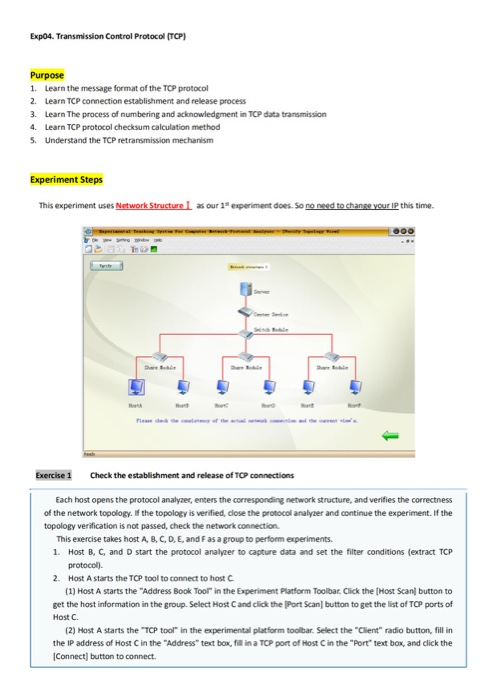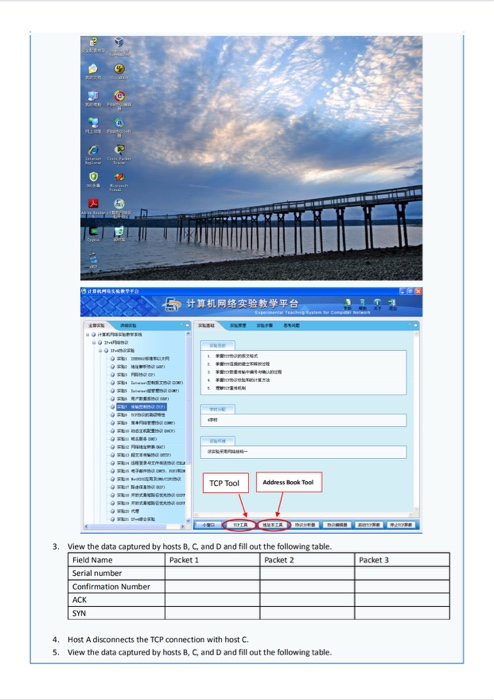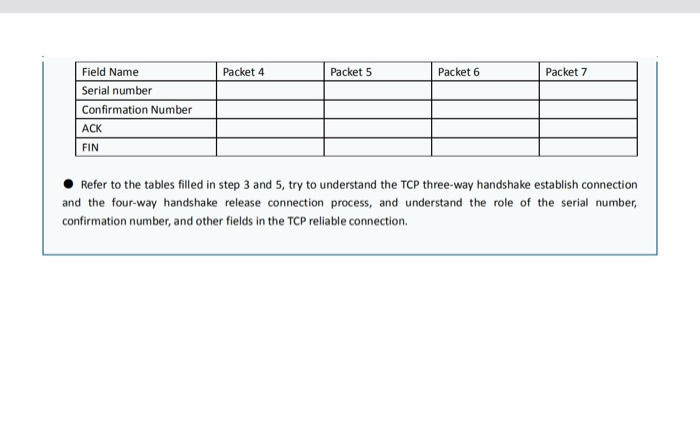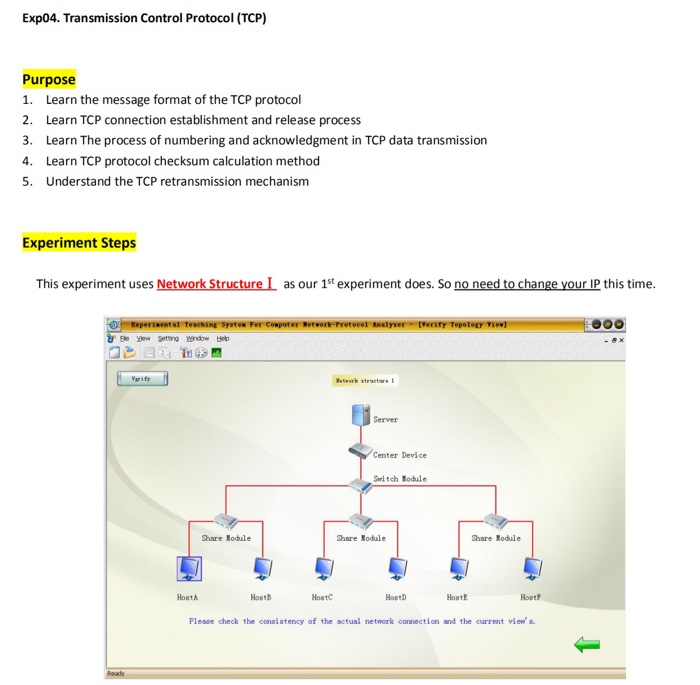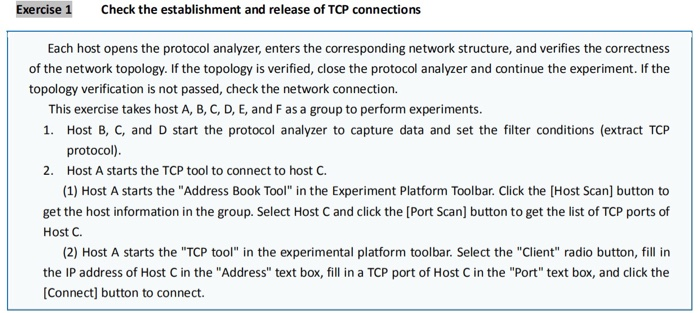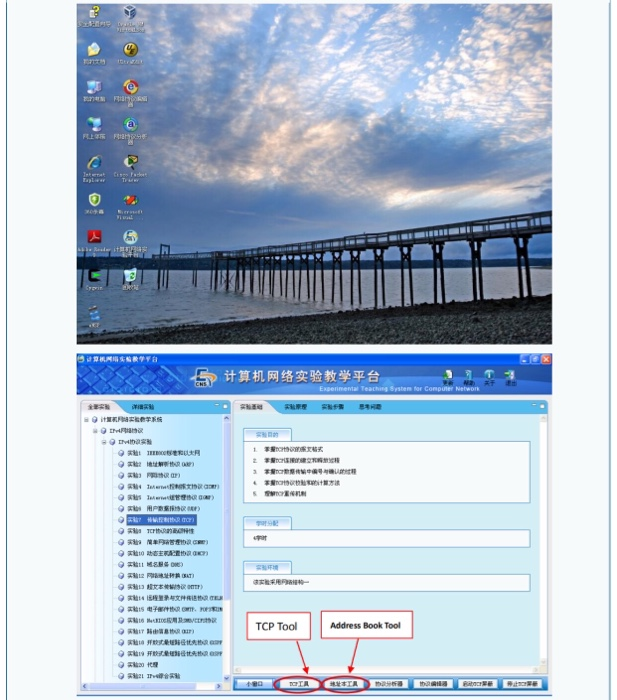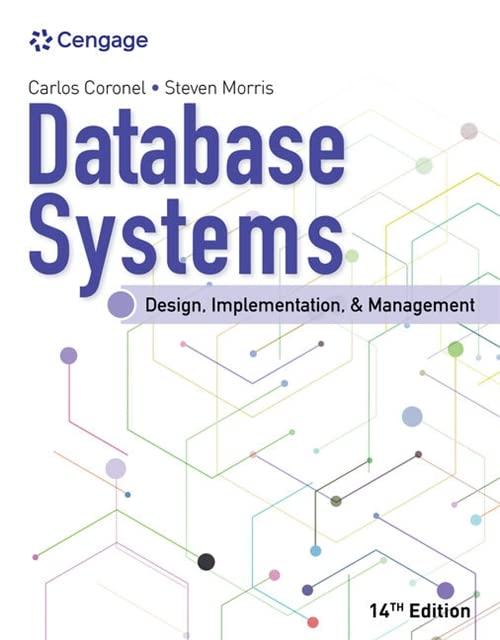Exp04. Transmission Control Protocol (TCP) Purpose 1. Learn the message format of the TCP protocol 2. Learn TCP connection establishment and release process 3. Learn The process of numbering and acknowledgment in TCP data transmission 4. Learn TCP protocol checksum calculation method 5. Understand the TCP retransmission mechanism Experiment Steps This experiment uses Network Structure I as our 1" experiment does. So no need to change your IP this time. 000 Server Fiee dea de aten Exercise 1 Check the establishment and release of TCP connections Each host opens the protocol analyzer, enters the corresponding network structure, and verifies the correctness of the network topology. If the topology is verified, close the protocol analyzer and continue the experiment. If the topology verification is not passed, check the network connection. This exercise takes host A, B, C, D, E, and Fasa group to perform experiments. 1. Host B, C, and D start the protocol analyzer to capture data and set the filter conditions (extract TCP protocol). 2. Host A starts the TCP tool to connect to host C (1) Host A starts the "Address Book Toor in the Experiment Platform Toolbar. Click the [Host Scanj button to get the host information in the group. Select Host Cand click the Port Scan] button to get the list of TCP ports of Host C. (2) Host A starts the "TCP tool" in the experimental platform toolbar. Select the "Client" radio button, fill in the IP address of Host Cin the "Address" text box, fill in a TCP port of Host Cin the "Port" text box, and click the (Connect) button to connect. Jatr DRAEAERT TCP Tool Address Book Tool 3. View the data captured by hosts B, C, and D and fill out the following table. Packet 2 Field Name Packet 1 Packet 3 Serial number Confirmation Number ACK SYN 4. Host A disconnects the TCP connection with host C. 5. View the data captured by hosts B, C, and D and fill out the following table. Field Name Packet 4 Packet 5 Packet 6 Packet 7 Serial number Confirmation Number ACK FIN Refer to the tables filled in step 3 and 5, try to understand the TCP three-way handshake establish connection and the four-way handshake release connection process, and understand the role of the serial number, confirmation number, and other fields in the TCP reliable connection. Exp04. Transmission Control Protocol (TCP) Purpose Learn the message format of the TCP protocol 1. 2. Learn TCP connection establishment and release process 3. Learn The process of numbering and acknowledgment in TCP data transmission 4. Learn TCP protocol checksum calculation method Understand the TCP retransmission mechanism 5. Experiment Steps This experiment uses Network Structure I as our 1st experiment does. So no need to change your IP this time. O Experientl Tesching Syste Fer Computer Netvor-Protocol Analyser- (Verity TopoloEY Vie) Ele ew Setting wndow Heb 000 Varify Neteerk stretw Server Center Device Switch Hodule Share Hodule Share Nodule Share Hodule Host HostD HostA Hostb HostC HostE Please check the consistency of the actual network connection and the current view's. Ready Exercise 1 Check the establishment and release of TCP connections Each host opens the protocol analyzer, enters the corresponding network structure, and verifies the correctness of the network topology. If the topology is verified, close the protocol analyzer and continue the experiment. If the topology verification is not passed, check the network connection. This exercise takes host A, B, C, D, E, and F as a group to perform experiments. 1. Host B, C, and D start the protocol analyzer to capture data and set the filter conditions (extract TCP protocol). Host A starts the TCP tool to connect to host C. 2. (1) Host A starts the "Address Book Tool" in the Experiment Platform Toolbar. Click the [Host Scan] button to get the host information in the group. Select Host C and click the [Port Scan) button to get the list of TCP ports of Host C. (2) Host A starts the "TCP tool" in the experimental platform toolbar. Select the "Client" radio button, fill in the IP address of Host C in the "Address" text box, fill in a TCP port of Host C in the "Port" text box, and click the (Connect] button to connect. Intenat Cispo Fadt ayt Crovin CNS Experimental Teaching System for Computer Networn 1. Address Book Tool TCP Tool 919 u Bitac View the data captured by hosts B, C, and D and fill out the following table. 3. Field Name Packet 1 Packet 2 Packet 3 Serial number Confirmation Number ACK SYN Host A disconnects the TCP connection with host C. 4. 5. View the data captured by hosts B, C, and D and fill out the following table. Field Name Packet 5 Packet 6 Packet 7 Packet 4 Serial number Confirmation Number ACK FIN Refer to the tables filled in step 3 and 5, try to understand the TCP three-way handshake establish connection and the four-way handshake release connection process, and understand the role of the serial number, confirmation number, and other fields in the TCP reliable connection. Exp04. Transmission Control Protocol (TCP) Purpose 1. Learn the message format of the TCP protocol 2. Learn TCP connection establishment and release process 3. Learn The process of numbering and acknowledgment in TCP data transmission 4. Learn TCP protocol checksum calculation method 5. Understand the TCP retransmission mechanism Experiment Steps This experiment uses Network Structure I as our 1" experiment does. So no need to change your IP this time. 000 Server Fiee dea de aten Exercise 1 Check the establishment and release of TCP connections Each host opens the protocol analyzer, enters the corresponding network structure, and verifies the correctness of the network topology. If the topology is verified, close the protocol analyzer and continue the experiment. If the topology verification is not passed, check the network connection. This exercise takes host A, B, C, D, E, and Fasa group to perform experiments. 1. Host B, C, and D start the protocol analyzer to capture data and set the filter conditions (extract TCP protocol). 2. Host A starts the TCP tool to connect to host C (1) Host A starts the "Address Book Toor in the Experiment Platform Toolbar. Click the [Host Scanj button to get the host information in the group. Select Host Cand click the Port Scan] button to get the list of TCP ports of Host C. (2) Host A starts the "TCP tool" in the experimental platform toolbar. Select the "Client" radio button, fill in the IP address of Host Cin the "Address" text box, fill in a TCP port of Host Cin the "Port" text box, and click the (Connect) button to connect. Jatr DRAEAERT TCP Tool Address Book Tool 3. View the data captured by hosts B, C, and D and fill out the following table. Packet 2 Field Name Packet 1 Packet 3 Serial number Confirmation Number ACK SYN 4. Host A disconnects the TCP connection with host C. 5. View the data captured by hosts B, C, and D and fill out the following table. Field Name Packet 4 Packet 5 Packet 6 Packet 7 Serial number Confirmation Number ACK FIN Refer to the tables filled in step 3 and 5, try to understand the TCP three-way handshake establish connection and the four-way handshake release connection process, and understand the role of the serial number, confirmation number, and other fields in the TCP reliable connection. Exp04. Transmission Control Protocol (TCP) Purpose Learn the message format of the TCP protocol 1. 2. Learn TCP connection establishment and release process 3. Learn The process of numbering and acknowledgment in TCP data transmission 4. Learn TCP protocol checksum calculation method Understand the TCP retransmission mechanism 5. Experiment Steps This experiment uses Network Structure I as our 1st experiment does. So no need to change your IP this time. O Experientl Tesching Syste Fer Computer Netvor-Protocol Analyser- (Verity TopoloEY Vie) Ele ew Setting wndow Heb 000 Varify Neteerk stretw Server Center Device Switch Hodule Share Hodule Share Nodule Share Hodule Host HostD HostA Hostb HostC HostE Please check the consistency of the actual network connection and the current view's. Ready Exercise 1 Check the establishment and release of TCP connections Each host opens the protocol analyzer, enters the corresponding network structure, and verifies the correctness of the network topology. If the topology is verified, close the protocol analyzer and continue the experiment. If the topology verification is not passed, check the network connection. This exercise takes host A, B, C, D, E, and F as a group to perform experiments. 1. Host B, C, and D start the protocol analyzer to capture data and set the filter conditions (extract TCP protocol). Host A starts the TCP tool to connect to host C. 2. (1) Host A starts the "Address Book Tool" in the Experiment Platform Toolbar. Click the [Host Scan] button to get the host information in the group. Select Host C and click the [Port Scan) button to get the list of TCP ports of Host C. (2) Host A starts the "TCP tool" in the experimental platform toolbar. Select the "Client" radio button, fill in the IP address of Host C in the "Address" text box, fill in a TCP port of Host C in the "Port" text box, and click the (Connect] button to connect. Intenat Cispo Fadt ayt Crovin CNS Experimental Teaching System for Computer Networn 1. Address Book Tool TCP Tool 919 u Bitac View the data captured by hosts B, C, and D and fill out the following table. 3. Field Name Packet 1 Packet 2 Packet 3 Serial number Confirmation Number ACK SYN Host A disconnects the TCP connection with host C. 4. 5. View the data captured by hosts B, C, and D and fill out the following table. Field Name Packet 5 Packet 6 Packet 7 Packet 4 Serial number Confirmation Number ACK FIN Refer to the tables filled in step 3 and 5, try to understand the TCP three-way handshake establish connection and the four-way handshake release connection process, and understand the role of the serial number, confirmation number, and other fields in the TCP reliable connection
